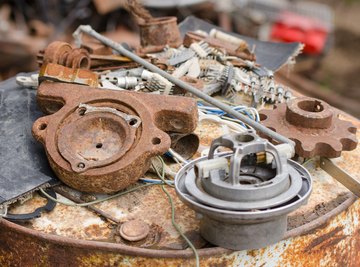
Metals of all types are important and valuable resources. Although their natural supply or the supplies of elements that go into producing various alloys are fixed, metals are highly recyclable and reusable. Precious metals, such as gold and silver, are rarely, if ever, discarded. Even used industrial metals are valuable commodities. Roadside America reports that the world's largest sculpture is made from metal scraps. The 320-ton "Forevertron" is located in North Freedom, Wisconsin.
Definitions
The Merriam Webster dictionary defines a renewable resource as one that is capable of being replaced by natural or ecologic cycles. Examples of renewable resources are trees, wind and water. A nonrenewable resource, of course, cannot be naturally replaced. Typically, nonrenewable resources are found in the ground, such as rocks, fossil fuels and minerals. Once they are depleted, they are gone forever.
Metal as a Resource
Metals, such as:
- copper
- tin
- lead
- aluminum
- gold
- silver
- are elements
They are nonrenewable. Steel is are made from iron, which is also nonrenewable. Aluminum, iron and titanium are among the three most abundant elements in the Earth's crust.
Recycling
Although the elements and resources that go into producing metal products are nonrenewable, metal can be recycled, making it a hybrid between renewable and nonrenewable classification. According to the Institute of Scrap Recycling Industries, or ISRI, as cited by Earth911.com, "81.6 million tons of iron and steel, 5 million tons of aluminum and 1.8 million tons of copper" are recycled each year. Other recyclable metals include brass, zinc, magnesium, tin and lead. Many of these can be recycled endlessly, eliminating the need for virgin, nonrenewable resources.
Value
Metals are the highest-priced recyclable materials. In August 2010, the London Metal Exchange price for aluminum averaged over $2,000 per ton, lead averaged over $19,000 per ton, copper over $7,300 per ton and tin averaged $14,300 per ton, according to RecycleInMe.com. Although prices fluctuate over time, metals are continually more valuable than other recyclables, such as paper or plastic. You can easily sell gold, silver or platinum for cash. Scrap metal is one of the two major exports that the United States sends to China.
Benefits
There are many benefits to recycling metals in addition to their cash value. Recycling them saves nonrenewable resources and reduces the need for additional mining. Producing new products from recycled metals saves a great deal of energy. The ISRI estimates that making beverage cans from recycled aluminum uses 95 percent less energy than making them from bauxite. Reducing energy demands also reduces the demand for the fossil fuels used to create it. Fossil fuels are also nonrenewable.
References
About the Author
Ann Deiterich has been a writer since 1984 in business-to-business communications, specializing in TQM, business/financial topics, office management and production efficiency. As an environmental proponent, nature and science are her areas of interest. Deiterich holds a Bachelor of Arts in English from Albright college and has three expert rating certifications including Grammar, Words/Phrases and Advertising Skills.
Photo Credits
Madhourse/iStock/Getty Images
